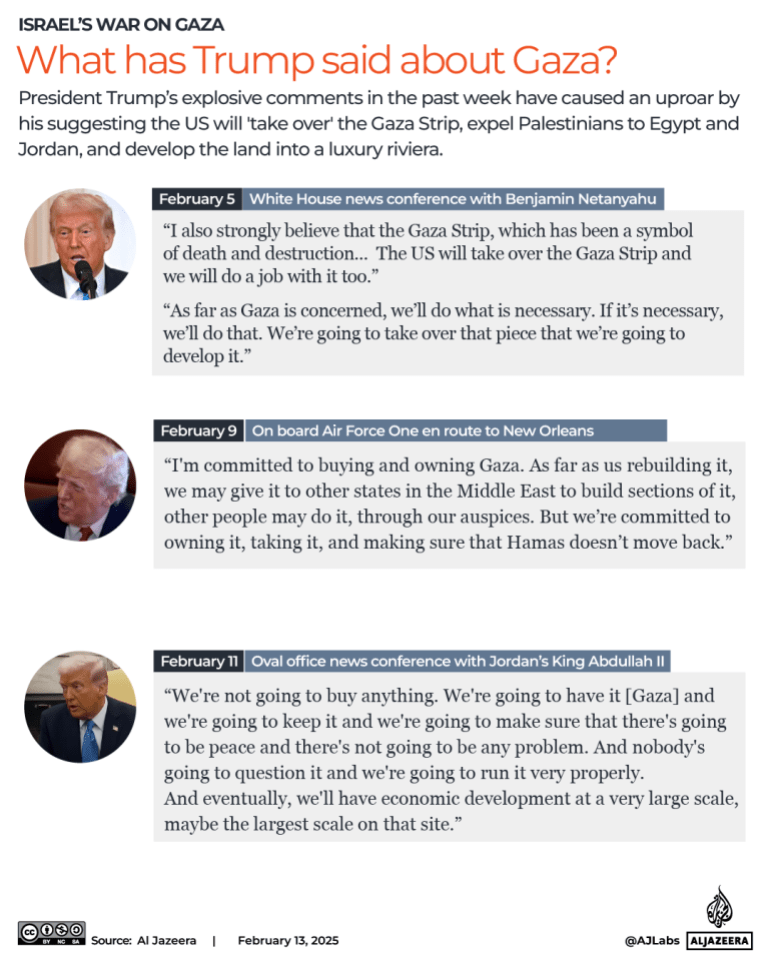Israel is set to return 369 Palestinian prisoners being held in Israeli jails as part of the sixth phase of the exchange.
The Palestinian group Hamas released three more Israeli captives in the Gaza Strip as the sixth such exchange pushed ahead following days of tense negotiations that threatened to undo the precarious ceasefire.
The three captives – identified as American-Israeli Sagui Dekel-Chen, Russian-Israeli Alexander Sasha Trufanov, and Argentinian-Israeli Yair Horn – were released to members of the International Committee of the Red Cross during a brief ceremony on Saturday in Gaza’s southern city of Khan Younis.
All three were among those taken by Hamas following its October 7 attack on southern Israel.
Dekel-Chen, Trufanov and Horn were seen carrying certificates for their release and maps of Palestine. They were transported back to Israel for medical examinations before reuniting with their families.
With Saturday’s handover, the number of captives released by Hamas and Palestinian Islamic Jihad has reached 25 since the ceasefire began on January 19.
Dozens of armed Hamas and Islamic Jihad fighters guarded the square where the handover took place.
Hundreds of Palestinian civilians, including women, children and the elderly, gathered behind the security cordon trying to witness the release.
Al Jazeera’s Tarek Abu Azzoum, reporting from the site in Khan Younis, described preparations for the release as “highly coordinated” and “marked by a strict security protocol and symbolic display of power”.
‘What is going to happen next?’
Hamas issued a statement after the release saying it was “a renewed message” to Israel.
“The release of the sixth batch of enemy prisoners, confirms there is no way to free them except through negotiations and by adhering to the requirements of the ceasefire agreement,” the group said.
In return for the three captives, Israel is set to return 369 Palestinian prisoners who have been held in Israeli jails, most without any charges or convictions. It is the largest number of Palestinians to be freed since the beginning of the ceasefire.
Most of the prisoners were arrested in Gaza and will be sent back to the besieged enclave. About 10 will be released in the occupied West Bank, one in occupied East Jerusalem, and 25 will either be sent to Gaza or Egypt.
Muhanad Seloom of the Doha Institute for Graduate Studies told Al Jazeera so far both parties to the ceasefire are trying to stick to the agreement.
“The tough negotiations would be what comes after the first phase. While the focus is on the release of the hostages, the main question should be what is going to happen the next day?” he said.
“What we see now is Hamas sticking to its end of the deal. Israel is more elusive about it, which signals it might not be committed to the second phase.”
‘No migration except to Jerusalem’
Uri Dromi, a retired Israeli colonel, said, “every Israeli is glued to their TV screen” watching the handover.
“At the same time, people are looking beyond the present event and asking themselves here what will happen in Gaza the next day,” he told Al Jazeera from Tel Aviv.
Referring to US President Donald Trump’s proposal to remove all Palestinians from Gaza, he said: “I would hope to see some change in the region – some better future for the people of Gaza. As long as Hamas and the Islamic Jihad are pulling the strings there, it is not going to happen,” Dromi said.
Trump’s proposal to forcibly displace Palestinians has been roundly rejected by Palestinian groups and countries in the region.
“We say to the whole world: there is no migration except to Jerusalem, and this is our response to all the calls for displacement and liquidation launched by Trump and those who support his approach from the forces of colonialism and occupation,” said Hamas.